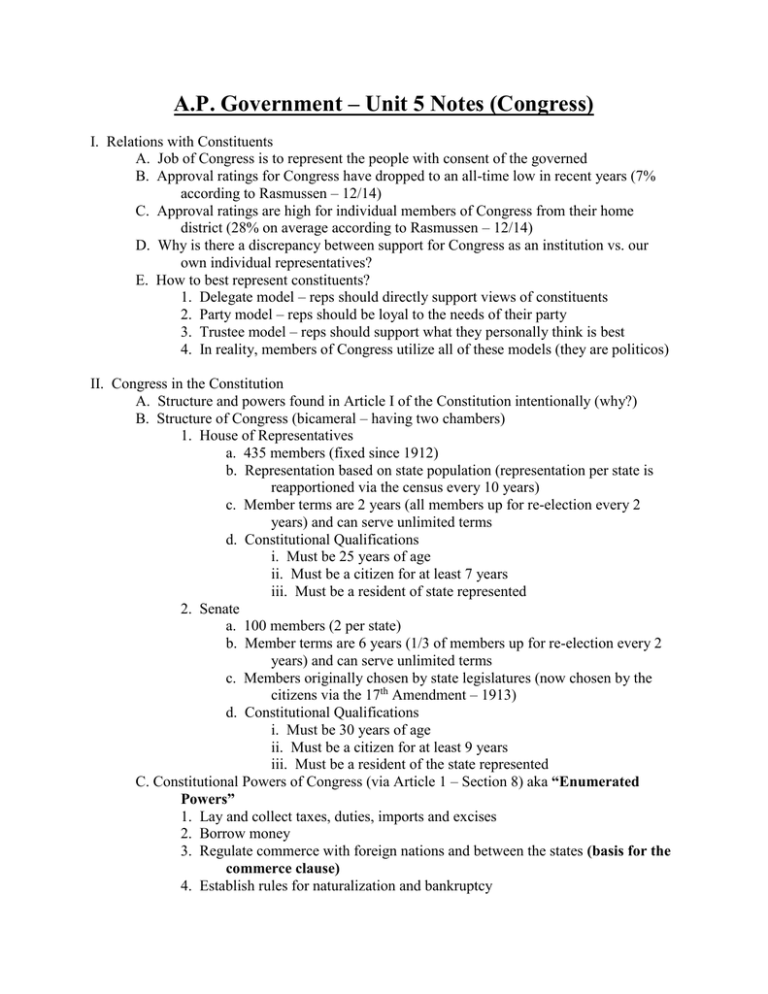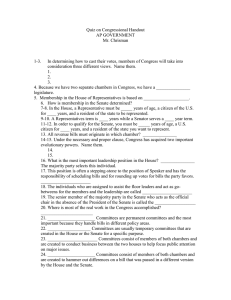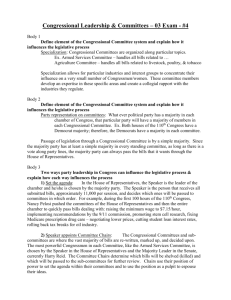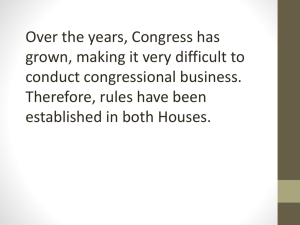AP Government – Unit 5 Notes (Congress)
advertisement

A.P. Government – Unit 5 Notes (Congress) I. Relations with Constituents A. Job of Congress is to represent the people with consent of the governed B. Approval ratings for Congress have dropped to an all-time low in recent years (7% according to Rasmussen – 12/14) C. Approval ratings are high for individual members of Congress from their home district (28% on average according to Rasmussen – 12/14) D. Why is there a discrepancy between support for Congress as an institution vs. our own individual representatives? E. How to best represent constituents? 1. Delegate model – reps should directly support views of constituents 2. Party model – reps should be loyal to the needs of their party 3. Trustee model – reps should support what they personally think is best 4. In reality, members of Congress utilize all of these models (they are politicos) II. Congress in the Constitution A. Structure and powers found in Article I of the Constitution intentionally (why?) B. Structure of Congress (bicameral – having two chambers) 1. House of Representatives a. 435 members (fixed since 1912) b. Representation based on state population (representation per state is reapportioned via the census every 10 years) c. Member terms are 2 years (all members up for re-election every 2 years) and can serve unlimited terms d. Constitutional Qualifications i. Must be 25 years of age ii. Must be a citizen for at least 7 years iii. Must be a resident of state represented 2. Senate a. 100 members (2 per state) b. Member terms are 6 years (1/3 of members up for re-election every 2 years) and can serve unlimited terms c. Members originally chosen by state legislatures (now chosen by the citizens via the 17th Amendment – 1913) d. Constitutional Qualifications i. Must be 30 years of age ii. Must be a citizen for at least 9 years iii. Must be a resident of the state represented C. Constitutional Powers of Congress (via Article 1 – Section 8) aka “Enumerated Powers” 1. Lay and collect taxes, duties, imports and excises 2. Borrow money 3. Regulate commerce with foreign nations and between the states (basis for the commerce clause) 4. Establish rules for naturalization and bankruptcy 5. Coin money 6. Fix the standard of weights and measures 7. Establish a post office and post roads 8. Issue patents and copyrights 9. Create courts (besides the Supreme Court) 10. Define and punish piracy 11. Declare war 12. Raise and support an army and navy 13. Provide for a militia 14. Exercise exclusive legislative powers over the District of Columbia and other federal facilities 15. “Make all laws which shall be necessary and proper for carrying into execution of the foregoing powers” (aka the Elastic Clause) 16. Specific Powers for the House i. All revenue bills (taxes) must be introduced first in the House ii. Impeachment for “high crimes and misdemeanors” iii. Chooses president if Electoral College does not have a majority (one vote per state) 17. Specific Powers of the Senate i. Confirmation of presidential appointments for federal judges, ambassadors and Cabinet officials with “advice and consent” power ii. Ratification of treaties with a 2/3 majority iii. Conviction power in impeachment trials iv. Chooses the vice-president if Electoral College does not have a majority III. Evolutionary Powers A. Not found explicitly in the Constitution, developed over time and maintained due to tradition B. Oversight of the budget (created by the President) 1. Authorization bills – setting the maximum amount of $$ for a government program 2. Appropriation bills – setting the actual amount of $$ for a government program C. Investigative Powers 1. Study important issues (ex. causes for 9/11 attacks) 2. Investigate illegal activity in government (ex. Watergate Scandal) 3. Example of Congress having quasi-judicial power IV. Leadership A. Role of political parties to determine the “majority” and “minority” in each chamber 1. Majority party determines the top leadership positions in their caucus held at the beginning of each term of Congress 2. Minority party determines other leadership positions in their caucus held at the beginning of each terms of Congress B. House of Representatives 1. Speaker of the House (most powerful position in the House) a. Paul Ryan (R-WI) b. Chosen by the majority party c. Historically all-powerful in the chamber, but limited in power since 1910 reforms d. Powers: i. Recognition of members who wish to speak in the chamber ii. Ruling on questions of parliamentary procedure iii. Appointing members to select and conference committees iv. Directing business on the floor v. Exercising significant behind the scenes influence vi. Appointing members to the committees who appoint members to standing legislative committees vii. Exercising substantial control over which bills get assigned to which committees viii. Appointing the party’s legislative leaders 2. Majority Leader a. Kevin McCarthy (R-CA) b. Top assistant to the Speaker c. Usually a stepping stone position to becoming eventual Speaker d. Responsible for scheduling bills and rounding up votes for the majority 3. Majority Whip a. Steve Scalise (R-LA) b. Liaison between the party leadership and chamber members c. Counts votes for important bills and pressures members to vote with the majority 4. Minority Leader a. Nancy Pelosi (D-CA) b. Spokesperson for the minority party c. Usually becomes Speaker if party becomes the majority d. Very little influence over policymaking with the majority 5. Minority Whip a. Steny Hoyer (D-MD) b. Liaison between the party leadership and chamber members c. Counts votes for important bills and pressures members to vote against the majority party C. Senate 1. President of the Senate a. Joe Biden (D-V.P. of the US, per the Constitution) b. Doesn’t have any real power other than break ties c. Almost never appears in the Senate 2. President Pro Tempore a. Orrin Hatch (R-UT) b. Always the longest serving member of the majority party 3. 4. 5. 6. c. Technically, temporary president of the Senate, but the position is just ceremonial with no actual real power Majority Leader (most powerful position in the Senate) a. Mitch McConnell (R-KY) b. Determines the Senate’s agenda (with consultation from the minority leader historically) c. Lots of influence over committee assignments Majority Whip a. John Cornyn (R-TX) b. Similar responsibilities as the House version Minority Leader a. Harry Reid (D-NV) b. Assists (when able) the majority leader with setting the Senate’s agenda c. Lots of influence over committee assignments for the minority party Minority Whip a. Dick Durbin (D-IL) b. Similar responsibilities as the House version V. Committees A. Place where the majority of Congress’s work gets done B. Standing Committees 1. Legislative committees that create bills and exist for a long time 2. Important examples (House Ways and Means Com, Senate Judiciary Com) C. Select Committees 1. Temporary investigative committees 2. Ex. – Steroids in Baseball, Impact of the Mafia D. Joint Committees 1. Committees that are made up of BOTH House and Senate members 2. Can be investigative or legislative in nature 3. Ex. (Printing Com, Iran-Contra Affair Com) E. Conference Committee 1. Special type of joint committee that hammers out differences between House and Senate versions of the same bill 2. Once the committee comes up with a unified bill, it goes back to both chambers for approval F. Work of Committees 1. Majority party has a proportional majority on EVERY COMMITTEE and chairs each committee 2. Committee Assignments a. House of Rep. i. Republicans – Committee on Committees ii. Democrats – Steering Committee b. Senate Steering Committees by party c. Committee Chairs are not necessarily based on seniority but rather by secret ballot by committee members) 3. Which committee to desire as a member? a. Junior members usually take on committees that are important to their states or districts (ex. Kansas Congressman serving on the House Agriculture Com) to help with future re-election b. More senior members from safe states/districts usually try to get on more power committees (ex. Senate Foreign Relations Com or House Appropriations Com) VI. Caucuses A. Groupings of members of Congress with the same interests (almost like interest groups within Congress itself) B. Push for policies that are beneficial to their caucus C. Types of Caucuses 1. Regional a. Sunbelt Caucus b. Northeast-Midwest Congressional Coalition 2. Minority Status a. Congressional Black Caucus b. Women’s Caucus 3. Economic a. Steel Caucus b. Mushroom Caucus 4. Party a. House Republican b. Senate Democratic D. Hundreds of caucuses exist in Congress VII. Staff A. Approx. 30,000 assistants for committees and members of Congress B. Personal Staffers 1. Draft legislation, organize member’s schedules work with the media 2. Casework – work with helping constituents’ problems in home states/districts 3. Average Senator – 30 staffers, average Congressman – 15 staffers C. Congressional Research Service (CRS) D. General Accountability Office (GAO) E. Congressional Budget Office (CBO) VIII. Who is in Congress? A. Typical Demographic Background: 1. Male (80%) 2. College educated from wealthy economic status 3. Mostly Protestant 4. White (Over 80%) 5. Middle-aged (average age 57) 6. More-likely a former lawyer, but maybe a businessman or other professional B. Controversy about the representativeness of members C. Significant gains for minority members (ethnically, religiously and gender) D. Power of incumbents (existing members seeking re-election) 1. Congressmen get re-elected over 80% of the time, Senators get re-elected about 65% of time ------------ career members 2. Name recognition 3. Franking privilege (ability to provide free mailings to constituents) 4. More experience in campaigning, ability to access donor money 5. Exceptions for incumbency advantage a. Scandal, b. Presidential coat-tails c. Redistricting E. Should members of Congress have term limits? IX. Representation in Congressional Districts A. History of challenges B. Malapportionment 1. History of having unequal sized districts (usually to limit power of ethnic minorities) 2. Baker v. Carr (1962) – Voters can challenge the constitutionality of congressional districts 3. Wesberry v. Sanders (1964) – creates “one man, one vote” guideline that states that each citizens’ representation have equal weight C. Gerrymandering 1. Drawing of congressional districts by the majority party in the state legislature to create an advantage for the majority party 2. “Packing” and “Cracking” 3. See Ohio Congressional District Map D. Today, congressional districts must be geographically contiguous and represent almost 700,000 people each E. Controversy over mid-decade redistricting in Texas (2003) X. How a Bill Becomes a Law A. Intentionally designed to be a long, difficult process by the Founders B. Introduction of a Bill (over 11,000 introduced each term) 1. Bills started in both chambers in any order (except revenue bills) 2. Anybody can create a bill, but it must be formally introduced by a member of Congress 3, Assigned a number (ex. H.R. 215, S. 21) C. Use of Resolutions (passing measures without the traditional law-making route) 1. Simple Resolution a. Used to establish rules or guidelines (not having the force of law) within a specific chamber b. Used to recognize something of minor importance (ex. member’s birthday) 2. Concurrent Resolution – used to pass procedural matters that affect both chambers 3. Joint Resolution a. Requires approval from both chambers of Congress and the President (has the force of law) b. Used to create policy when time is exceptionally short (ex. following 9/11) D. Bills in Committee 1. Assigned to appropriate committee 2. Bills are then generally assigned to an appropriate sub-committee (most legislative work done here) a. Most bills get “pigeonholed” (forgotten about and die) b. Possible use of hearings c. Mark-ups/amendments (editing, rewriting of bills) d. Debates e. Vote ---------- majority approve, it moves on to full committee, majority disapprove, it typically dies 3. Full Committee a. More possible hearings b. More mark-ups/amendments c. More debates e. Vote ---------- majority approve, it moves on to full chamber, majority disapprove, it typically dies 4. Some bills can bypass House committees with the passage of a “discharge petition” (218 votes) and go straight to the floor 5. House Rules Committee a. Chaired by the Speaker b. Sets formal rules for debate on the bill on the floor i. Closed rule – no amendments, little debate (only committee members) ii. Open rule – allowance for amendments, full debate from all members with little limit on time c. No such committee exists in the Senate, approved bills from full committees go straight to the floor E. Floor Debate 1. Bill must be placed on appropriate chamber calendar (non-linear) 2. House Committee of the Whole (100 members) for important bills 3. Recent House policy of “Majority of the Majority” status in order to get on the floor 4. Possible additional mark-ups/amendments (many of which are not germane to the bill itself, creating “Christmas Tree Bills”) 5. House uses rules for debate set by the Rules Committee 6. Senators have unlimited debate time a. Use of filibusters i. Using unlimited debate time to intentionally prevent a bill from getting voted on ii. Can only be stopped with a cloture vote (60% majority) iii. Dramatic increase in use over the last 15 years (now considered SOP for the passage of bills) b. Use of holds (delaying votes in order for members more time to study the issue) F. Voting 1. Voice voting (either as a group or individually “Roll call”) 2. Division voting by standing 3. Electronic voting with cards (most common) 4. Bills with a majority vote from BOTH CHAMBERS move on, others typically die G. Conference Committees H. Presidential Action 1. Signs bill ----------- Becomes LAW!!!! 2. Vetoes bill a. Bill typically dies b. Congressional Override (2/3 majority of BOTH CHAMBERS) ------------------ Becomes LAW!!! 3. Fails to sign within 10 days of passage by Congress -------Becomes LAW!!! 4. Fails to sign within last 10 days of a term of Congress ------ Pocket Veto (bill dies) 5. Line-item vetoes a. Ability of the president to veto only a portion of a bill while allowing the rest to become law b. Passed into law during Clinton years (1990s) c. Found unconstitutional by the Supreme Court – Clinton v. New York (1998) over separation of power concerns 6. Use of signing statements a. Making formal notice that parts of a law are considered unconstitutional to the president b. Usually indicates that areas in legislation in question may not be fully enforced by the president XI. Criticisms of Congress A. “Pork Barrel” Legislation 1. Bills with provisions that are usually considered as unnecessary and wasteful financially that specifically benefit a member’s state/district 2. Famous example – Alaska’s “Bridge to Nowhere” 3. Recent legislation has significantly reduced pork in laws, but it still exists B. Logrolling 1. Process of members of Congress to promise to support each other’s bills regardless of it is beneficial for the nation 2. “You scratch my back, I’ll scratch yours” C. Use of hidden “earmarks” 1. Notes from congressional committee debates that dictate where generalized money passed in law should go, without the members of the entire chamber actually voting on the specific measure 2. Recent action by President George W. Bush has significantly reduced hidden earmarks in laws, but it still exists D. Growing party polarization ------------------- Increased “gridlock”






